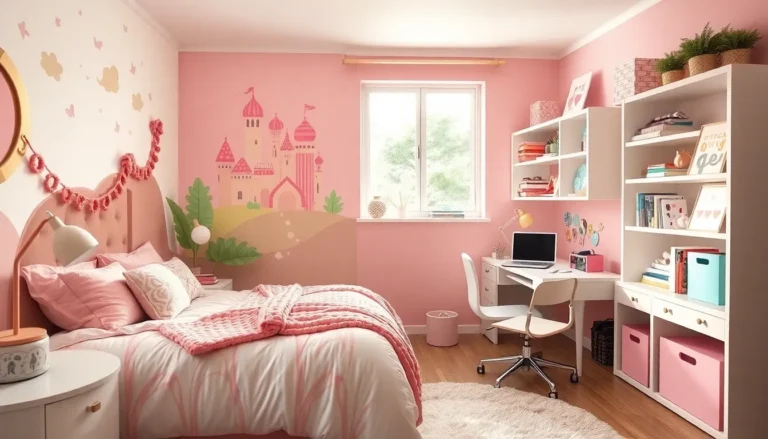Lighting does more than just illuminate a space; it transforms the atmosphere and enhances the overall design. Decorative lighting fixtures play a crucial role in achieving that perfect ambiance, adding both style and functionality to any room. From elegant chandeliers to modern pendant lights, these fixtures serve as focal points that elevate interior aesthetics.
As homeowners and designers seek to create unique environments, the right lighting can make all the difference. With an array of styles, materials, and designs available, choosing the perfect decorative lighting fixture becomes an exciting journey. This article delves into the various types of decorative lighting options, offering insights on how to select the ideal pieces that reflect personal taste while complementing existing decor.
Table of Contents
ToggleOverview of Decorative Lighting Fixtures
Decorative lighting fixtures serve both functional and aesthetic purposes in residential and commercial spaces. They create ambiance, highlight design elements, and act as statement pieces in a room. Available in various styles, these fixtures include chandeliers, pendant lights, sconces, and floor lamps.
Chandeliers add elegance and sophistication. They often feature intricate designs and can be made from materials like crystal, glass, or metal. Common placements include dining rooms and entryways.
Pendant lights provide versatility and style. With options ranging from industrial to contemporary, they fit well in kitchens, dining areas, and living spaces. Multiple pendants can create a dramatic effect.
Sconces are ideal for accent lighting. They install on walls and provide both functional and decorative illumination. Common uses include hallways and beside mirrors or artwork.
Floor lamps offer flexibility in placement. They come in various designs and heights, making them suitable for reading corners or standing alone in spacious areas.
Table lamps enhance surfaces and provide localized lighting. Typically used on bedside tables or desks, they come in styles that align with other decor.
Decorative lighting fixtures play a crucial role in design aesthetics, enhancing the overall atmosphere of a space while offering various options to suit personal preferences and interior themes.
Types of Decorative Lighting Fixtures

Various types of decorative lighting fixtures enhance aesthetics and functionality in spaces. Here are some popular categories that elevate design.
Chandeliers
Chandeliers serve as striking focal points in spaces. Often crafted from materials like crystal, glass, or metal, they provide elegance and sophistication. Commonly used in dining rooms and entryways, chandeliers create a dramatic effect while offering ambient light. Styles range from traditional designs with ornate detailing to modern minimalistic versions that suit contemporary decor.
Pendant Lights
Pendant lights offer versatility and style in various settings. Suspended from the ceiling, they come in numerous designs, shapes, and sizes. Ideal for kitchens and dining areas, pendant lights can serve as task lighting or decorative accents. Their placement above islands, tables, or counters enhances functionality and adds visual interest.
Wall Sconces
Wall sconces provide excellent accent lighting while maximizing wall space. Typically affixed to walls, sconces enhance ambiance by casting light upwards or downwards. They suit hallways, living rooms, and bedrooms, where they can highlight artwork or architectural features. Sconces come in diverse styles, from sleek and modern to vintage-inspired designs, allowing for seamless integration with existing decor.
Materials Used in Decorative Lighting Fixtures
Various materials contribute to the design and functionality of decorative lighting fixtures. Key materials include metal, glass, and fabric, each offering unique characteristics that enhance aesthetics and performance.
Metal
Metal serves as a popular choice for decorative lighting fixtures due to its durability and versatility. Commonly used metals include stainless steel, brass, and wrought iron. Stainless steel offers a modern look and resists rust, making it suitable for damp areas. Brass adds warmth and elegance, frequently found in traditional designs, while wrought iron provides a rustic, vintage appeal, perfect for classic settings. Finishes, such as matte, polished, or brushed, further customize the appearance of metal fixtures.
Glass
Glass adds elegance and sophistication to decorative lighting fixtures. Different types of glass, such as clear, frosted, and colored glass, create varied effects in light transmission. Clear glass provides maximum light output, making spaces feel larger and brighter. Frosted glass diffuses light, reducing glare and creating a soft ambiance. Colored glass introduces a playful element, enhancing color themes in interior spaces. Additionally, artisanal glass techniques like blown or etched glass introduce texture and artistry, making each piece unique.
Fabric
Fabric plays a crucial role in softening the look of decorative lighting fixtures. Used in shades for table lamps, pendant lights, and chandeliers, fabric choices include cotton, linen, and silk. Cotton offers durability and easy maintenance, making it suitable for everyday use. Linen lends a natural, textured feel, while silk introduces luxury and refinement, often seen in higher-end lighting designs. Fabrics also come in various colors and patterns, allowing for personalization in decor. The choice of fabric significantly influences the quality of light emitted, shaping the overall ambiance of the space.
Choosing the Right Decorative Lighting Fixtures
Selecting appropriate decorative lighting fixtures plays a critical role in enhancing interior spaces. Consideration of size, style, and function ensures that lighting harmonizes with the overall design.
Consideration of Space
Space affects the choice of decorative lighting fixtures significantly. Assess the dimensions of the room before selecting fixtures. For larger spaces, consider grand chandeliers or multiple pendant lights for balance, while smaller rooms benefit from compact lighting solutions like wall sconces or mini pendants. Additionally, analyze the ceiling height; high ceilings can accommodate larger fixtures, while lower ceilings may require flush mounts or low-profile lights. Ensure that the lighting complements existing furniture and décor, creating a cohesive visual experience throughout the area.
Style and Design
Style influences the aesthetic impact of decorative lighting fixtures. Identify the predominant design theme of the space, whether it’s modern, traditional, industrial, or bohemian. For modern settings, sleek metal fixtures or geometric designs work well, whereas traditional spaces might benefit from classic chandeliers or ornate lamps. Consider color schemes; cohesive colors enhance the fixture’s visual appeal. Mix and match materials like glass, metal, and fabric to create a layered design. Ultimately, the right combination of style and design elevates the ambiance, making lighting a focal point rather than an afterthought.
Installation and Maintenance Tips
Installing decorative lighting fixtures requires attention to detail for optimal results. Follow these steps for proper installation:
- Choose the Right Location: Select areas that maximize illumination and aesthetics. Consider height and proximity to surfaces when positioning ceiling fixtures or wall sconces.
- Turn Off Power: Ensure safety by turning off the circuit breaker before beginning any installation. Verify the power is off using a voltage tester.
- Use Appropriate Tools: Equip yourself with tools like a screwdriver, drill, and wire stripper. Ensure these tools match the fixture requirements for a smooth installation process.
- Follow Manufacturer Instructions: Adhere closely to the instructions accompanying the fixture. Each fixture may have specific installation steps for secure attachment and wiring connections.
- Secure Fixtures Properly: Affix the fixture tightly to the ceiling or wall to prevent wobbling or the risk of falls. Use anchors and screws as recommended.
- Connect Wires Accurately: Match wires according to their colors, typically black to black, white to white, and ground wires to the fixture’s green wire. Use wire nuts for secure connections.
- Restore Power and Test: Once installed, restore power at the circuit breaker and test the fixture to ensure it operates correctly.
Regular maintenance keeps decorative lighting fixtures in prime condition. Implement these routine maintenance tips:
- Dust Regularly: Dust fixtures weekly using a soft cloth to prevent dirt buildup. A clean fixture maintains its brightness and appeal.
- Replace Bulbs Promptly: Replace burnt-out bulbs immediately to maintain consistent light levels. Choose bulbs that match recommended wattage to prevent heat damage.
- Check for Loose Connections: Periodically check connections for any looseness or wear. Tighten screws and connections to ensure safety and functionality.
- Inspect for Damage: Examine fixtures regularly for signs of wear, rust, or breakage. Address any issues immediately to prevent further damage.
- Renew Finish: Clean freestanding lamps and wrought iron fixtures with appropriate cleaners to maintain their appearance. Use products designed for specific materials to avoid damage.
These installation and maintenance practices enhance the lifespan and effectiveness of decorative lighting fixtures, ensuring they continue to accentuate spaces beautifully.
Decorative lighting fixtures play a crucial role in defining the character of any space. By thoughtfully selecting the right pieces, individuals can create inviting atmospheres that reflect their personal style. The variety of options available—from stunning chandeliers to sleek sconces—ensures there’s a perfect fit for every room.
Proper installation and regular maintenance are key to maximizing the beauty and functionality of these fixtures. With a little attention, decorative lighting can elevate a home’s aesthetic while providing practical illumination. Embracing the art of lighting design not only enhances interiors but also transforms everyday living into a more enjoyable experience.



